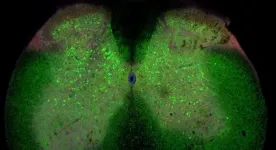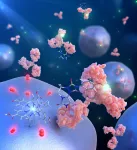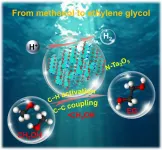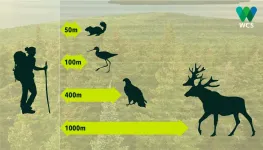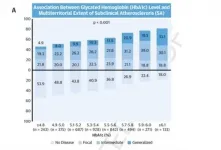(Press-News.org) ALS is a very severe neurodegenerative disease in which nerve cells in the spinal cord controlling muscles and movement slowly die. There is no effective treatment and the average life expectancy after being diagnosed with ALS is usually short. Because of this, new knowledge about the disease is urgently needed.
Now, researchers from the University of Copenhagen have gained new insights about ALS, by investigating the early development of the disease in a mouse model.
"We have found that networks of nerve cells in the spinal cord called inhibitory interneurons lose connection to motor neurons, the nerve cells that directly control muscle contraction. We do not yet know if these changes cause the disease. But the loss of the inhibitory signal could explain why the motor neurons end up dying in ALS", says first and co-corresponding author to the new study Ilary Allodi, Assistant Professor at the Department of Neuroscience.
A lot of ALS research have focused on the motor neurons themselves, but the research group at the University of Copenhagen had a different approach.
"It is only natural that motor neurons have received major attention. They control our muscles, which is the challenge for ALS patients. Here, we wanted to investigate the circuit of interneurons in the spinal cord because they determine the activity of motor neurons. Since we found that there is a loss of connections between inhibitory interneurons and motor neurons that happens before the motor neuron death, we think that this loss could be a possible explanation for why the motor neurons ends up dying in ALS patients", says Ole Kiehn, senior, co-corresponding author and Professor at the Department of Neuroscience.
Fast-twitch first
In ALS patients, the degeneration typically starts with what is called the fast-twitch motor neurons and then goes on to other motor neurons. This means that certain muscles and bodily functions are affected before others. Normally, patients lose coordination and speed in movement before more basic functions such as breathing. This is mirrored in the new findings, according to the researchers.
"In our mouse model, we show that the loss of connection happens to fast motor neurons first and then slow motor neurons later on involve a particular type of inhibitory neurons, the so called V1 interneurons", says Roser Montañana-Rosell, who is PhD student and shared first author on the study.
"The V1 interneuron connectivity loss is paralleled by the development of a specific locomotor deficit in the pre-symptomatic phase with lower speed and changes in limb coordination in the ALS mice that is dependent on V1 interneuron connections to motor neuron", says Ole Kiehn.
Expanding the window of opportunity
The researchers underline that the mechanisms should be investigated in human patients as well. However, they do not have any reason to believe that the same or similar biological mechanisms are not at play in humans.
Given the new understanding of the disease, Ilary Allodi hopes further research into the signaling process could reveal how to repair the nerve cell connection loss in ALS.
"We definitely hope that our findings can contribute with a new way of thinking about ALS development. With a distinct focus on interneurons, we might be able, in future experiments, to increase the signaling processes from the interneurons to the motor neurons and prevent or delay the motor neuron degeneration from an early stage," ends Ilary Allodi.
INFORMATION:
Read the entire study in Nature Communications: "Locomotor deficits in a mouse model of ALS are paralleled by loss of V1-interneuron connections onto fast motor neurons"
Researchers have created a new nanometer-scale proximity labeling system that targets histidine residues quickly, providing a new chemical tool in protein chemical modification.
The results of their research were published in the Journal of the American Chemical Society on April 27, 2021.
Protein chemical modification, a technology that introduces functions into the chemical structure of proteins through irreversible strong bonds, is used for the creation of protein-based biomaterials and for drug delivery systems.
In order to carry out modification, protein labeling is necessary. Proximity labeling is one of those techniques. It labels biomolecules located close to a protein of interest which can then also be marked ...
The photochemistry of the future will spring up human industry without smoke, and bring a brighter civilization based on the utilization of solar energy instead of fossil energy. Photochemistry has been used in controlling many reaction processes, especially for the challenging reactions containing selective C-H activation and C-C coupling in chemical synthesis. It is of great interests that a "dream catalytic reaction" of direct coupling of methanol to ethylene glycol (2CH3OH ? HOCH2CH2OH + H2, denoted as MTEG) could be achieved through the solar energy-driven C-H activation and C-C coupling processes, and this MTEG reaction has not been achieved through thermocatalysis yet.
Ethylene glycol (EG) is an important monomer for the manufacture of polymers (e.g., poly(ethylene ...
Spending time outdoors is good for a person's body and soul, but how good is it for the wildlife around us?
Outdoor recreation has become a popular activity, especially in the midst of a pandemic, where access to indoor activities might be limited. Long known to have negative behavioural and physiological effects on wildlife, outdoor recreation is one of the biggest threats to protected areas. Human disturbance to animal habitats can lower their survival and reproduction rates, and ultimately shrink populations or eradicate them from areas where they would ...
Researchers have identified the key factors that influence a vital pattern of ocean currents.
The Atlantic meridional overturning circulation (AMOC) carries warm water from the tropics northward.
Many scientists think that this heat transport makes areas including north-west Europe and the UK warmer than they would otherwise be.
Climate models suggest the AMOC is likely to weaken over the coming decades, with widespread implications for regional and global climate.
The new study - led by the universities of Exeter and Oxford, and published in Nature Geoscience - pinpoints the causes of monthly and annual AMOC variation and finds a differing picture at two key locations.
Observational data came from large ...
The Covid-19 pandemic has introduced us to expressions like 'lockdown', 'isolation' and 'social distancing', which became part of social conduct all over the world. Now it appears that bats also maintain social distancing which might help prevent the spread of contagious diseases in their colonies. In a new study published in Annals of the New York Academy of Science, researchers from Tel Aviv University demonstrate that sick bats, just like ill humans, prefer to stay away from their communities, probably as a means for recovery, and possibly also as a measure for protecting others. The study was conducted by postdoctoral researcher Dr. Kelsey Moreno and PhD candidate Maya Weinberg ...
Methane emissions from North American livestock may be routinely undercounted, a new analysis by researchers at New York University and Johns Hopkins University finds. The work also notes that in developing countries, where animal agriculture is becoming increasingly industrialized, methane emissions could rise more than expected.
These assessments are based on a review, appearing in the journal Environmental Research Letters, of eight existing studies.
Methane is a global warming gas even more powerful than CO2. Its amount and lifetime in the atmosphere are smaller than CO2, but quantities are still increasing. The United Nations has recently ...
RNA sequencing is a powerful technology for studying cells and diseases. In particular, single-cell RNA sequencing helps uncover the heterogeneity and diversity of our body. This is the central technology of the "Human Cell Atlas" in its quest to map all human cells. However, single-cell RNA sequencing reaches its limits in very large projects, as it is time-consuming and very expensive. To address these challenges, scientists from the research group of Christoph Bock, principal investigator at the CeMM Research Center for Molecular Medicine of the Austrian Academy of Sciences and professor at the Medical University of Vienna, developed ...
Researchers at the Biomedicine Institute of Seville (IBiS) have discovered a new mechanism of Alzheimer's disease that disorganises the blood vessels around amyloid plaques, one of the characteristic features of the disease. The study, published in the international journal Nature Communications, was led by the laboratory of Dr. Alberto Pascual, from the Neuronal Maintenance Mechanisms Group at IBiS and was chiefly carried out by María Isabel Álvarez Vergara and Alicia E. Rosales-Nieves.
Relevance of the finding
Alzheimer's disease is the leading cause of dementia worldwide. In Spain, its incidence is increasing dramatically as the population ages and yet, unfortunately, the origin of the disease is still unknown.
The mechanism put forward ...
New research has found that adolescents with higher levels of an omega-3 fatty acid in their blood were less likely to develop psychotic disorder in early adulthood, suggesting that it may have a potential preventative effect of reducing the risk of psychosis.
The study, led by researchers from RCSI University of Medicine and Health Sciences, is published in END ...
The routine use of the glycosylated hemoglobin test to track blood sugar levels in the general population can identify individuals with more advanced atherosclerotic disease. Currently used in the diagnosis and management of diabetes, glycosylated hemoglobin can provide a useful estimate of atherosclerotic disease, and therefore of cardiovascular risk, in individuals without diabetes with or without possible prediabetes. This is the main finding of a study carried out by scientists at the Centro Nacional de Investigaciones Cardiovasculares (CNIC).
The advance heralded by the CNIC study is the use of this blood-sugar measure in apparently healthy middle-aged ...
